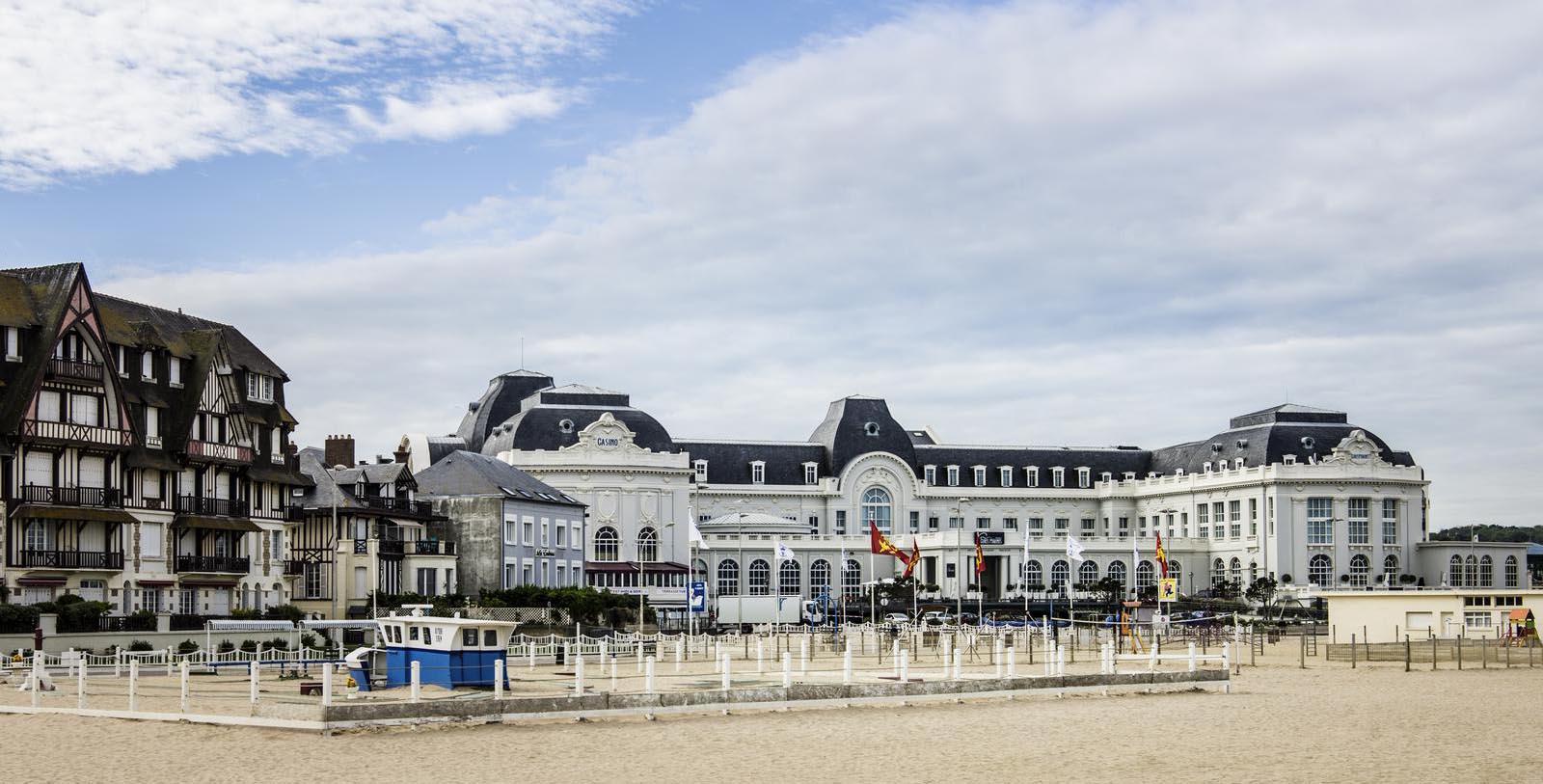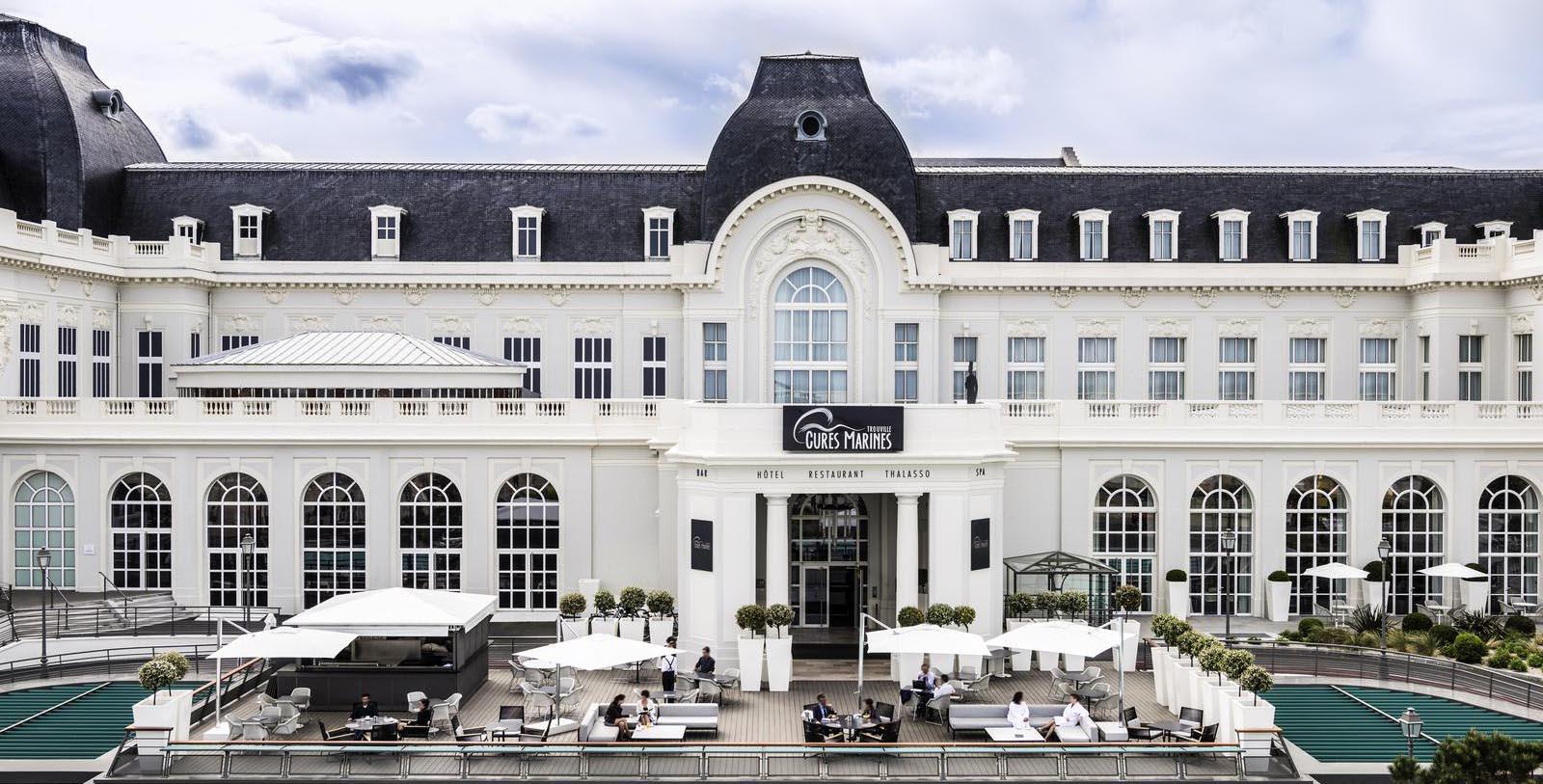Receive for Free - Discover & Explore eNewsletter monthly with advance notice of special offers, packages, and insider savings from 10% - 30% off Best Available Rates at selected hotels.
history
Discover the Cures Marines Trouville Hôtel Thalasso & Spa - MGallery by Sofitel, which was once one of Europe's largest casinos.
Cures Marines Trouville Hôtel Thalasso & Spa - MGallery by Sofitel, a member of Historic Hotels Worldwide since 2018, dates back to 1912.
VIEW TIMELINEA member of Historic Hotels Worldwide since 2018, the Cures Marines Trouville Hôtel Thalasso & Spa - MGallery by Sofitel is intimately tied to the surrounding town of Trouville-sur-Mer. In 1830, two artists named Eugène Isabey and Charles Mozin discovered this quaint seaside village in their quest to locate the perfect spot from which to paint the beautiful Norman coastline. Their arrival marked the beginning for Trouville-sur-Mer’s emergence as an admired vacation destination. Easily within reach of the Parisian suburbs, this tiny fishing port rapidly grew into a majestic resort community. Soon, many people from across France traveled to Trouville-sur-Mer to rejuvenate both the mind and body. The town’s bucolic charm became so alluring by the end of the century that it encouraged the creation of numerous, endearing monikers, including “Queen of the Côte Fleurie.” As Trouville-sur-Mer grew into a prevalent holiday retreat, entrepreneurs decided to build an extravagant casino to accommodate the town’s new visitors. Known as the “Casino Trouville-sur-Mer,” the business was among the entire region’s most prolific establishments. But in the early 20th century, the casino’s manager, Eugène Cornuché, was determined to renovate the building upon the opening of a rival venue across the Touqes estuary. Amazingly, Cornuché’s ambitious construction project only took 15 months to complete. When it concluded in 1912, the building—reborn as the “Casino Municipal de Trouville”—stood as Europe’s largest casino. Despite the building’s newfound grandiose appeal, Cornuché’s vision eventually came to naught. By the of the Great Depression, the casino had lost too much of its business to local competitors, Casino de Deauville and Casino du Normandy. The Casino Municipal de Trouville sat dormant for the next several decades, save for a partial renovation by the city in 2011. Fortunately, the building underwent a cultural renaissance, thanks in large part to both AccorHotels and the COFINANCE group. They subsequently transformed the structure into a luxury hotel just a couple years later to great acclaim. Now known as the “Cures Marines Trouville Hôtel Thalasso & Spa,” the two companies have since ensured that their work continues to preserve its fascinating cultural heritage.
-
About the Location +
Located along the picturesque Côte Fleurie, Trouville-sur-Mer is a beautiful coastal village in the heart of Normandy, France. While this quaint seaside hamlet is now a renowned resort community, it originally existed as nothing more than a remote fishing village on the English Channel. Its metamorphosis into a vacation retreat initially occurred when French artists began arriving en masse in the early 19th century. In 1830, two artists named Eugène Isabey and Charles Mozin discovered this quaint seaside village in their quest to locate the perfect spot from which to paint the beautiful Norman coastline. They were joined by many other artists over the next several decades, including the likes of Eugène Boudin and his famous protégé, Claude Monet. As such, images of Trouville-sur-Mer and its surrounding landscape proliferated throughout France, popularizing the locale for the first time in its history. Inspired, many wealthy French families began constructing their own villas amid the hedgerows of the local countryside. But a few aspiring hoteliers also started to open their own hotels and inns, as well as a variety of amazing storefronts, restaurants, and performance halls. By the beginning of the 1870s, Trouville-sur-Mer had emerged as the most popular of the French resort towns. In fact, the village’s bucolic charm became so alluring that it encouraged the creation of numerous, endearing it monikers like the “Queen of the Côte Fleurie.” But Trouville-sur-Mer still preserved aspects of its rich maritime past, continuing to support a lively fishing industry well into the present. The area’s white-sand beaches continue to draw thousands of visitors each year, particularly the Reine des Plage.
Normandy itself is characterized by a fascinating history. While different bands of Celtic people resided in the region throughout its antiquity, the first signs of permanent settlement appeared after Julius Caesar’s conquest of modern-day France in the 1st century BC. A loose network of roads soon connected Normandy together and dozens of unique Roman villas quickly dotted the landscape. But after the fall of the Roman Empire several centuries later, the area became a fiefdom within the Kingdom of the Franks. Various tribes of Saxon—and then Viking—raiders began pillaging the French shoreline, including the Norman coast. The climax of the marauding occurred when a Scandinavian fleet under the command of Hrólfr Ragnvaldsson (also known as “Rollo”) ransacked the communities on the Seine, before besieging Paris in 911. To prevent the warlord from completely ransacking the city, the ruling Frankish king, Charles the Simple, created the “Duchy of Normandy” for Hrólfr in exchange for his service. (In fact, the name “Normandy” reflected Hrólfr’s Viking heritage as a Norseman.) Hrólfr agreed, recognizing the power that would come with a feudal title. As such, he and his descendants ruled over Normandy for generations, adopting the local customs and melding them with their own. Over time, this cultural exchange gave rise to a new ethnicity of people known as the “Normans,” who would rise to become one of the most powerful societies in all of medieval Europe.
Perhaps the greatest Norman to rise to power was the great Duke William I, otherwise known as “William the Conqueror.” Born out of wedlock in the early 11th century, William would eventually rise to install himself as the King of England in 1066. His subsequent conquest of England established the revered Plantagenet dynasty, which ruled over country for the next three centuries. The influence of the Normans extended beyond merely Great Britain, though, as many other Norman lords created their own feudal domains elsewhere in the world. Perhaps the greatest were Tancred of Hauteville, Rainulf Drengot, whose families ruled over large swathes of territory in southern Italy, and the Levant. Other Normans from England later invaded Ireland, too, establishing their own fiefdoms under the auspices of the English monarchy. Despite their militaristic origins, the Normans raised magnificent buildings wherever they settled. In France, William the Conqueror oversaw the creation of great L'Abbaye-aux-Hommes in the Norman capital of Caen, while his fellow countrymen in Italy constructed such wonders like Catterdrale di Palermo and the Palazzo dei Normani. Nevertheless, Norman power in Europe was receded, following the military losses of King John I of England and King Roger II of Sicily throughout the 12th century. John’s ineptitude had a direct impact on Normandy itself, as the dukedom fell under the sole jurisdiction of the French crown. In response, the Plantagenet’s would fight a series of wars to regain the territory, culminating with their ultimate defeat at the end of the Hundred Years’ War.
Normandy would also play an important role in modern history, as it served as the site for one of the most climatic battles of World War II. In the early morning hours of June 6, 1944, some 80 miles of beach stretching from the vicinities of Carentan to Caen were the site of a massive amphibious invasion codenamed “Operation Overload.” Often remembered as “D-Day,” the invasion force consisted of nearly 352,000 Allied soldiers and sailors that attacked Normandy via a combined airborne and seaborne assault. The landing force was the first step in the Allied strategy to liberate western Europe from the oppression of German occupation. Despite pockets of light resistance, the fighting was savage and fierce. Nowhere was this reality more apparent than at Omaha Beach, in which several thousand American soldiers were killed in action within just a few hours. In all, more than 10,000 Allied soldiers died on June 6, making it one of the costliest battles that the Allies fought during the war. Still, Operation Overlord represented just the first step in the invasion. Over the next three months, the Allies struggled to dislodge the Germans from such Norman towns like Cherbourg, Saint-Lô, and Bayuex. In fact, Caen itself was transformed into a virtual wasteland by the time the Allies penetrated the dense Norman hedgerows at the end of August. Despite its extremely high causality rate, the subsequent Battle of Normandy eventually enabled the Allies to liberate Paris, as well as the rest of France by the end of 1944. Visitors today can walk the Normandy beaches where so many Allies soldiers gave their lives to bring about the ultimate defeat of Nazi Germany.
-
About the Architecture +
When a rival casino opened across the estuary from Trouville-sur-Mer, Eugène Cornuché endeavored to completely renovate his Casino Trouville-sur-Mer. He thoroughly rebuilt the structure right down to its foundation—a process that took 15 months in total to complete! Cornuché also decided to use elements of Classic Revival-style architecture into his designs. Also known as “Neoclassical,” Classic Revival architecture itself is among the most common architectural forms seen throughout the world today. This wonderful architectural style first became popular in Paris, specifically among French architectural students that studied in Rome in the late 18th century. Upon their return, the architects began emulating aspects of earlier Baroque design aesthetics into their designs, before finally settling on Greco-Roman examples. Over time, the embrace of Greco-Roman themes spread across the world, reaching destinations like Germany, Spain, and Great Britain. As with the equally popular Revivalist styles of the same period, Classical Revival architect found an audience for its more formal nature. It specifically relied on stylistic design elements that incorporated such structural components, like the symmetrical placement of doors and windows, as well as a front porch crowned with a classical pediment. Architects would also install a rounded front portico that possessed a balustraded flat roof. Pilasters and other sculptured ornamentations proliferated throughout the façade of the building, too. Perhaps the most striking feature of buildings designed with Classical Revival-style architecture were massive columns that displayed some combination of Corinthian, Doric, or Ionic capitals. With its Greco-Roman temple-like form, Classical Revival-style architecture was considered most appropriate for municipal buildings like courthouses, libraries, and schools. But the form found its way into more commercial uses over time, such as banks, department stores, and of course, hotels. Architects still rely on Classic Revival architecture when designing new buildings or renovating historic ones, making it among the most ubiquitous architectural styles in the world.


























